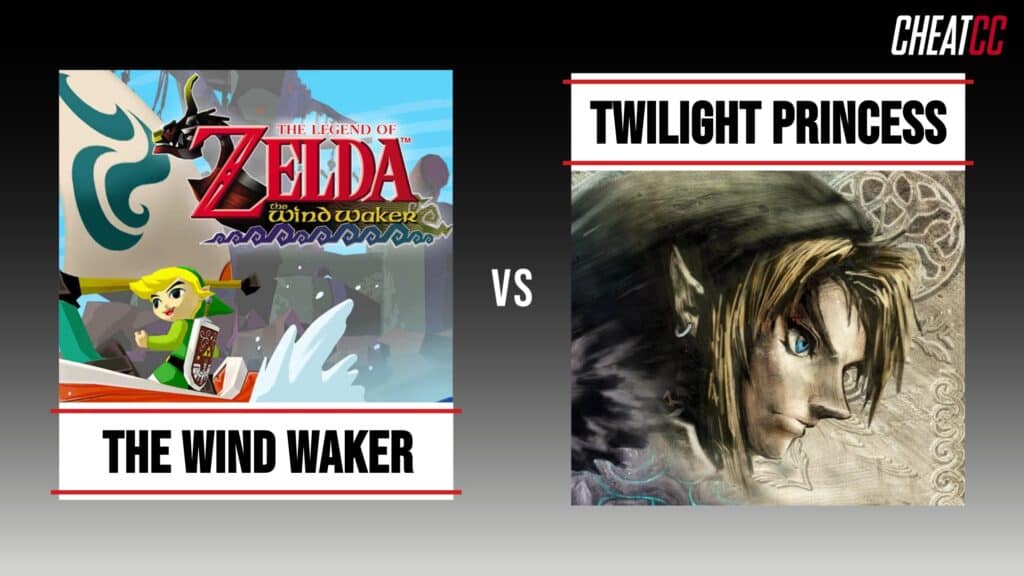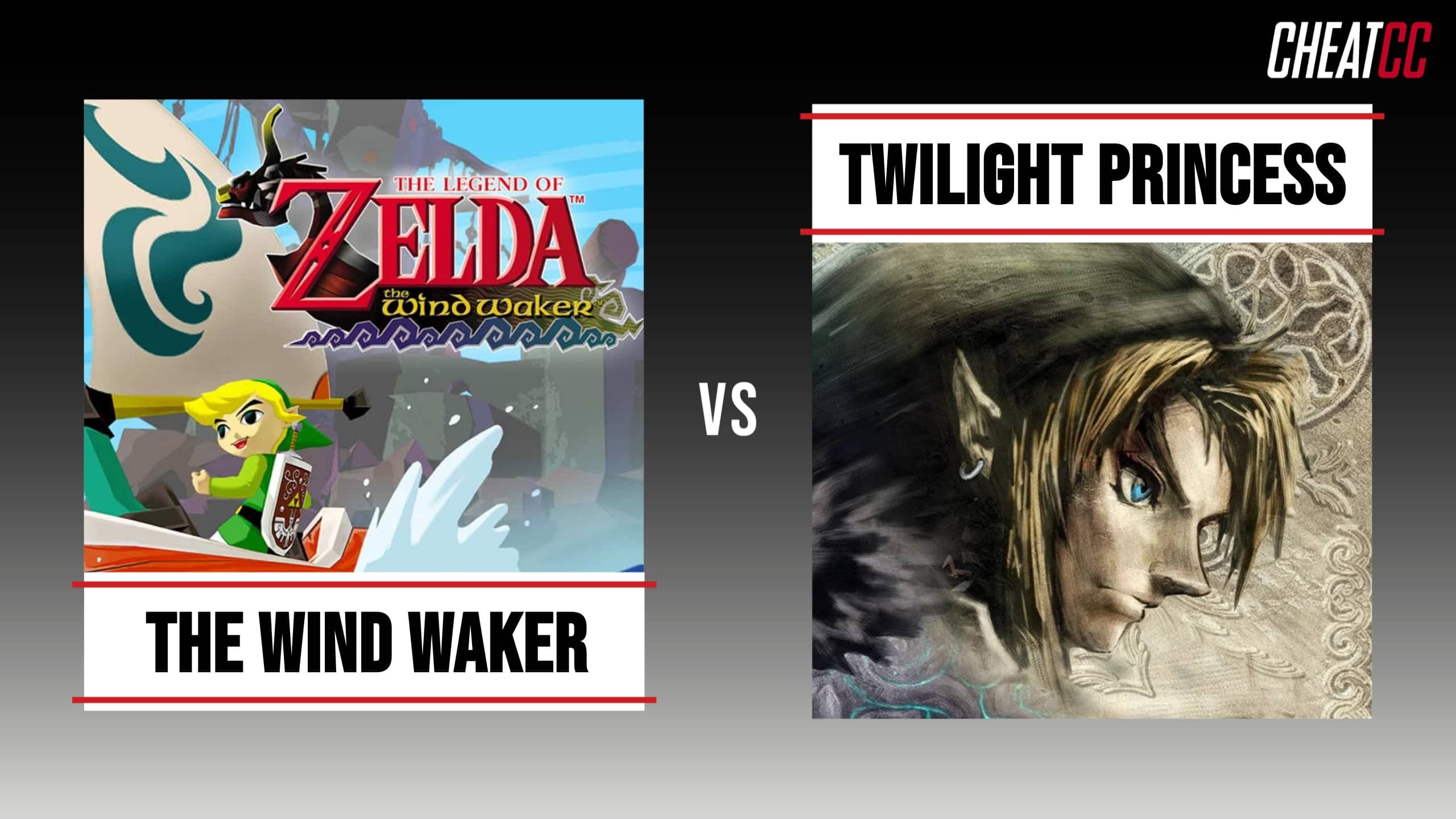One of the defining features of a Nintendo console generation is its releases in the Mario and Zelda franchises. The NES has three Super Mario Bros. titles and two in The Legend of Zelda series, the SNES has a similar ratio of two mainline Mario games to one Zelda, and the Nintendo 64 surprisingly only has one Mario title in Super Mario 64 while featuring two Zelda games in Ocarina of Time and Majora’s Mask. As it turns out, this trend of one major 3D Mario title compared to two entries in The Legend of Zelda franchise would continue on the GameCube, with Nintendo’s 6th generation console receiving both The Wind Waker and Twilight Princess.
In terms of The Legend of Zelda franchise, there might not be two entries more different than The Wind Waker and Twilight Princess. Following the darker turn of both Ocarina of Time and Majora’s Mask, many fans were very vocally upset about the reveal of The Wind Waker and its cartoonish, lighthearted art style. Twilight Princess, by comparison, was Nintendo’s course-correction from Wind Waker. Replacing the bright colors and whimsical atmosphere were the somber and sullen Link and the darkest looking Zelda title to-date.
Both of these entries in The Legend of Zelda franchise are excellent titles that no fan should miss, but their versions of the series’ iconic hero are near polar opposites. Zelda games feature a different Link in each title (with few exceptions) and the GameCube-era series titles disrupt the status quo by featuring two radically different versions of the franchise’s protagonist. In terms of which one is better, well, that depends on your Legend of Zelda preferences in a few key areas.
Wind Waker vs Twilight Princess: Side-by-Side Comparison

Aside from the obvious differences in each game’s tone and visual aesthetic, The Wind Waker and Twilight Princess also take quite a different approach to the 3D Zelda formula. Additionally, each game’s versions of series mainstays Link, Princess Zelda, and Ganon are quite different from one another. Whereas one game features a Hyrule completely submerged under a vast ocean, the other has Link hopping back and forth between the Light and Twilight Realms and their respective versions of Hyrule. To compare each of these GameCube Zelda games (and their respective Links) at a glance, let’s take a look at them side-by-side:
| Characteristic | The Wind Waker | Twilight Princess |
|---|---|---|
| Release Date | December 13, 2002 | November 19, 2006 |
| System(s) | GameCube, Wii U (HD Version) | GameCube, Wii, Wii U (HD Version) |
| Age of Link | 10-12 | 17 |
| Art Style | Cartoonish, Vivid | Realistic, Dark |
| Number of Dungeons | 7 | 9 |
| Setting | The Great Sea | Hyrule, Twilight Realm |
| Link’s Movement | Fluid, Quick | Weighted, Precise |
| Metacritic Score | 96 | 95 |
| Total Sales | 6.79 million | 10 million |
| Link amiibo | ✅ | ✅ |
Wind Waker vs Twilight Princess: 4 Must-Know Facts
Here are 4 must-know facts about The Wind Waker and Twilight Princess:
- The two radically different art styles between each game are as a result of complaints from fans against The Wind Waker. When Nintendo first debuted the GameCube at SpaceWorld 2000 it was running a tech demo showing what a next-gen Zelda title might look like. Nintendo’s reveal of Wind Waker was met with shock since it had a completely different art style than the realistic-looking Link on display in the tech demo.
- Despite the initial shock, The Wind Waker is one of the most critically successful Zelda titles of all-time. It holds the fourth-highest aggregate score of any other game in the series, sitting behind Breath of the Wild, Tears of the Kingdom, and Ocarina of Time.
- After the many departures from series tradition that Wind Waker takes, Twilight Princess is often jokingly referred to as “Ocarina of Time 2.0″. Indeed, Twilight Princess is very much a “classic” style 3D Zelda very much in the same style as the Nintendo 64 classic.
- The fan response to the more realistic and darker take on the Zelda series seems to have paid off for Nintendo, with sales of Twilight Princess greatly surpassing those of The Wind Waker. While Wind Waker may be the fourth best game in the series in terms of critical reception, Twilight Princess has the same distinction in terms of its sales. It’s the fourth best-selling series title behind Ocarina of Time, Tears of the Kingdom, and Breath of the Wild.
Wind Waker vs Twilight Princess: Radically Different Art Styles
Although the knee-jerk reaction from fans was to rally against the cartoonish art style on display in Wind Waker, it has since been looked back on much more fondly in retrospect. The style’s charm and appreciation among fans even helped to justify its use in two spin-off games on the 3DS – Phantom Hourglass and Spirit Tracks. In contrast, Twilight Princess is the only game in the series to use its extremely dark tone and realistic-looking anime-style characters. The darker, more realistic art style from Twilight Princess may not appear in another Zelda game but it has helped inspire a successful manga series.
Wind Waker vs Twilight Princess: Child Link or Adult Link?
One of the biggest questions players have about Link in Wind Waker is if he is a child. The game’s cartoonish art style makes it hard to determine whether this version of Link is an adult, and his appearance gives the impression that he’s much younger than the Link in Twilight Princess. Given how important the hero’s age is in the Zelda timeline (thanks to the branching realities following Ocarina of Time) fans continue to look for clues in Wind Waker to determine the age of its protagonist.
While the game does tell us that boys on Link’s island have to “come of age” before donning the green tunic of the Hero of Time, the best estimation on Link’s age is that he’s somewhere between the end of childhood and the beginning of his teenage years. Conversely, series producer Eiji Aonuma has previously confirmed that Link is precisely 17 years old in Twilight Princess.
Wind Waker vs Twilight Princess: Critical and Commercial Success
If you’re looking to determine which Zelda game has the better version of Link, a good barometer is the fan and critical reception to each title. After all, players spend their entire time in each game using Link as their avatar and the extension of the player, meaning that a more preferable Link could lead to greater sales and critical acclaim. Interestingly, here is where the battle between Wind Waker and Twilight Princess comes to a bit of a draw.
The Wind Waker slightly edges out Twilight Princess in terms of its aggregate score, sitting as one of the best-reviewed games in the entire franchise. On the other hand, Twilight Princess is one of the best-selling games in the franchise despite not reaching quite the same heights of critical reception. While it seems that many critics consider Wind Waker to be the better Zelda game, fans like the tone, aesthetic, and playable hero of Twilight Princess slightly more.
Bottom Line
Another factor to consider is how each Link plays, and it’s here that The Wind Waker may actually take the cake as having the best version of Link. Link looks undeniably cool in Twilight Princess, whether in human or wolf form, but his movement and grounded feel leave something to be desired. Link in The Wind Waker, on the other hand, is fluid and nimble, easily backflipping over enemies and quickly using the Master Sword to dispatch foes. Considering that most of the time players spend as Link is in traversing complex dungeons and taking down both regular and boss enemies, the cartoonish Link from Wind Waker reigns supreme as the best version of the hero from the GameCube-era.
